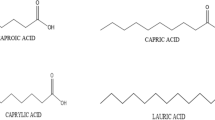Abstract
Hyperlipidemia is a major, modifiable risk factor for atherosclerosis and cardiovascular disease. In the present study, we have focused on the effect of different doses of geraniol (GOH) on the lipid profile and lipid metabolizing enzymes in atherogenic diet (AD) fed hamsters. Male Syrian hamsters were grouped into seven: group 1 were control animals; group 2 were animals fed GOH alone (200 mg/kg b.w); group 3 were animals fed AD (10 % coconut oil, 0.25 % cholesterol, and 0.25 % cholic acid); group 4 were animals fed AD + corn oil (2.5 ml/kg b.w); and groups 5, 6, and 7 were fed AD as in group 3 + different doses of GOH (50, 100, and 200 mg/kg b.w), respectively, for 12 weeks. At the end of the experimental period, animals were sacrificed by cervical dislocation and various assays were performed in the plasma and tissues. The AD hamsters showed marked changes in lipid profile and lipid metabolizing enzymes. However, supplementation with GOH counteracted the hyperlipidemia by inhibiting HMG CoA reductase and suppressing lipogenesis. The antihyperlipidemic efficacy of GOH was found to be effective at the dose of 100 mg/kg b.w. This study illustrates that GOH is effective in lowering the risk of hyperlipidemia in AD fed hamsters.










Similar content being viewed by others
References
Global status report on non-communicable diseases (2011) World Health Organization, Geneva
Weber C, Noels H (2011) Atherosclerosis: current pathogenesis and therapeutic options. Nat Med 17–11:1410–1422
Skoczynska A (2006) Patogenezamiażdżycy. Urban and Partner. Wrocław 1–5
Elson CE, Underbakke GL, Hanson P, Shrago E, Wainberg RH, Qureshi AA (1989) Impact of lemongrass oil, an essential oil, on serum cholesterol. Lipids 24:677–679
Shoff SM, Grummer M, Yatvin MB, Elson CE (1991) Concentration-dependent increase of murine P388 and B16 population doubling time by the acyclic monoterpene geraniol. Cancer Res 51:37–42
Carnesecchi S, Schneider Y, Ceraline J, Duranton B, Gosse F, Seiler N, Raul F (2001) Geraniol, a component of plant essential oils, inhibits growth and polyamine biosynthesis in human colon cancer cells. J Pharmacol Exp Ther 298:197–200
Carnesecchi S, Langley K, Exinger F, Gosse F, Raul F (2002) Geraniol, a component of plant essential oils, sensitizes human colonic cancer cell to 5-fluorouracil treatment. J Pharmacol Exp Ther 301:1–6
Korn ED (1955) Clearing factor: a heparin activated lipoprotein lipase: isolation and characterization of enzyme from normal rats. J Biol Chem 215:1–26
Folch J, Lees M, Solane SGH (1957) A simple method for isolation and purification of total lipids from animal tissues. J Biol Chem 26:497–509
Zlatkis A, Zak B, Boyle GJ (1953) A simple method for determination of serum cholesterol. J Clin Med Res 41:486–492
Fossati P, Lorenzo P (1982) Serum triglycerides determined colorimetrically with an enzyme that produces hydrogen peroxide. Clin Chem 28:2077–2080
Falholt K, Falholt W, Lund B (1973) An easy colorimetric method for routine determination of free fatty acids in plasma. Clin Chim Acta 46:105–111
Zilversmit BB, Davis AK (1950) Micro determination of plasma phospholipids by trichloroacetic acid precipitation. J Lab Clin Med 35:155–160
Venugopala Rao A, Ramakrishnan S (1975) Indirect assessment of hydroxyl methyl glutaryl CoA reductase (NADPH) activity in liver tissue. Clin Chem 21(10):1523–1525
Hitz J, Steinmetz J, Siest G (1983) Plasma lecithin: cholesterol acyltransferase––reference values and effects of xenobiotics. Clin Chim Acta 133:85–96
Mitchell, Richard S, Kumar V (2007) Robbins Basic Pathology: With student consult online Access (8th ed). Philadelphia: Saunders 345:1-4160–2973–7
Alice D, Nirupa RM, Alice HL (2010) Use of hamster as a model to study diet-induced atherosclerosis. Nutr Metab (Lond). doi:10.1186/1743-7075-7-89
Vijayakumar RS, Surya D, Rajagopal S (2002) Hypolipidemic effect of black pepper (Piper nigrum Linn.) in rats fed high fat diet. J Clin Biochem Nutr 32:31–42
Shah PK (1999) Plaque disruption and thrombosis: potential role of inflammation and infection. Cardiol Clin 17:271–281
Fitch ME, Mangels AR, Altmann WA (1989) Microbiological screening of mevalonate- suppressive minor plant constituents. J Agri Food Chem 37:687–691
Katan MB (2006) The response of lipoproteins to dietary fat and cholesterol in lean and obese persons. Curr Cardiol Rep 8:446–451
Farmer JA, Torre-Amione G (2000) Atherosclerosis and inflammation. Curr Atheroscler Rep 4:92–98
Silveira RC, Andrade NL, de Sousa DP (2013) A Review on anti-inflammatory activity of monoterpenes. Molecules 18:1227–1254
Shah SS, Shah GB, Singh SD, Gohil PV, Chauhan K, Shah KA, Chorawala M (2011) Effect of piperine in the regulation of obesity induced dyslipidemia in high fat diet rats. Indian J Pharmacol 43(3):296–299
Wu N, Sarna LK, Hwang SY (2013) Activation of 3-hydroxy-3-methylglutaryl coenzyme A (HMG-CoA) reductase during high fat diet feeding. Biochim Biophys Acta 10:1560–1568
Peffley DM, Gayen AK (2013) Plant-derived monoterpenes suppress hamster kidney cell 3-hydroxy-3-methylglutaryl coenzyme a reductase synthesis at the post-transcriptional level. J Nutr 133:38–44
Pattanayak M, Seth PK, Smita S, Gupta SK (2009) Geraniol and limonene interaction with 3- hydroxy-3-methylglutaryl-CoA (HMGCoA) reductase for their role as cancer chemo-preventive agents. J Proteomics Bioinform 2:466–474
Savel J, Lafitte M, Pucheu Y, Pradeau V (2012) Very low levels of HDL cholesterol and atherosclerosis, a variable relationship––a review of LCAT deficiency. Vasc Health Risk Manag 8:357–361
Vijayakumar RS, Nalini N (2006) Piperine, an active principle from Piper nigrum, modulates hormonal and apo lipoprotein profiles in hyperlipidemic rats. J Basic Clin Physiol Pharmacol 17:71–86
Conflict of interest
Authors declare no conflict of interest.
Author information
Authors and Affiliations
Corresponding author
Rights and permissions
About this article
Cite this article
Jayachandran, M., Chandrasekaran, B. & Namasivayam, N. Effect of geraniol, a plant derived monoterpene on lipids and lipid metabolizing enzymes in experimental hyperlipidemic hamsters. Mol Cell Biochem 398, 39–53 (2015). https://doi.org/10.1007/s11010-014-2203-3
Received:
Accepted:
Published:
Issue Date:
DOI: https://doi.org/10.1007/s11010-014-2203-3




